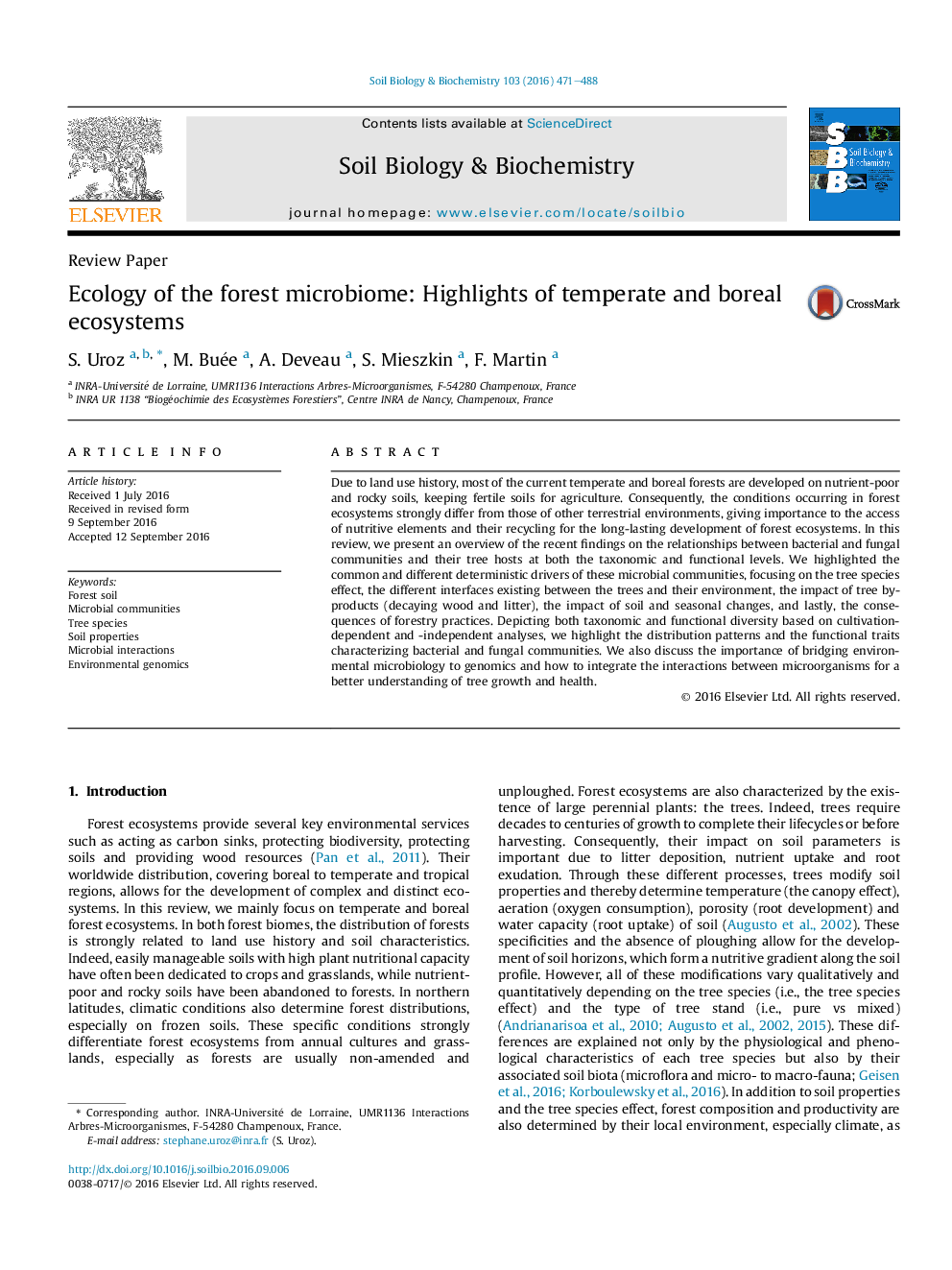| کد مقاله | کد نشریه | سال انتشار | مقاله انگلیسی | نسخه تمام متن |
|---|---|---|---|---|
| 8363352 | 1542581 | 2016 | 18 صفحه PDF | دانلود رایگان |
عنوان انگلیسی مقاله ISI
Ecology of the forest microbiome: Highlights of temperate and boreal ecosystems
ترجمه فارسی عنوان
محیط زیست از میکروبیومر جنگل: نکات برجسته ای از زیستگاه های معتدل و غربی
دانلود مقاله + سفارش ترجمه
دانلود مقاله ISI انگلیسی
رایگان برای ایرانیان
کلمات کلیدی
خاک جنگل، جوامع میکروبی، گونه های درختی، خواص خاک، تعاملات میکروبی، ژنومیک محیط زیست،
ترجمه چکیده
با توجه به تاریخچه استفاده از زمین، اکثر جنگل های معتدل و غربی در حال حاضر بر روی خاک های مضر فقیر و سنگی، حفظ خاک های حاصلخیز برای کشاورزی توسعه یافته است. در نتیجه، شرایطی که در اکوسیستم های جنگلی بوجود می آیند بسیار متفاوت از سایر محیط های زمینی است و اهمیت دسترسی به عناصر غذایی و بازیافت آنها را برای توسعه طولانی مدت اکوسیستم های جنگلی به ارمغان می آورد. در این بررسی، ما خلاصه ای از یافته های اخیر در ارتباط بین جوامع باکتری و قارچی و میزبان درختان در هر دو سطح تاکسونومیک و عملکردی ارائه می کنیم. ما برجسته های متداول و متنوعی از این جوامع میکروبی را برجسته کردیم، با تمرکز بر تاثیر گونه های درختی، رابط های مختلف بین درختان و محیط آنها، تاثیر محصولات زراعی درخت (چوب و بستر فرسوده)، تاثیر خاک و تغییرات فصلی، و در نهایت، پیامدهای اقدامات جنگلداری. با ارائه هر گونه تنوع طبقه بندی و عملکردی بر اساس تجزیه و تحلیل وابسته به کشت و مستقل، ما الگوهای توزیع و صفات کاربردی مشخصه جوامع باکتری و قارچی را مشخص می کنیم. ما همچنین در مورد اهمیت پیوند میکروب شناسی محیطی به ژنومیک و نحوه ادغام تعامل بین میکروارگانیسم ها برای درک بهتر رشد و سلامت درخت بحث می کنیم.
موضوعات مرتبط
علوم زیستی و بیوفناوری
علوم کشاورزی و بیولوژیک
دانش خاک شناسی
چکیده انگلیسی
Due to land use history, most of the current temperate and boreal forests are developed on nutrient-poor and rocky soils, keeping fertile soils for agriculture. Consequently, the conditions occurring in forest ecosystems strongly differ from those of other terrestrial environments, giving importance to the access of nutritive elements and their recycling for the long-lasting development of forest ecosystems. In this review, we present an overview of the recent findings on the relationships between bacterial and fungal communities and their tree hosts at both the taxonomic and functional levels. We highlighted the common and different deterministic drivers of these microbial communities, focusing on the tree species effect, the different interfaces existing between the trees and their environment, the impact of tree by-products (decaying wood and litter), the impact of soil and seasonal changes, and lastly, the consequences of forestry practices. Depicting both taxonomic and functional diversity based on cultivation-dependent and -independent analyses, we highlight the distribution patterns and the functional traits characterizing bacterial and fungal communities. We also discuss the importance of bridging environmental microbiology to genomics and how to integrate the interactions between microorganisms for a better understanding of tree growth and health.
ناشر
Database: Elsevier - ScienceDirect (ساینس دایرکت)
Journal: Soil Biology and Biochemistry - Volume 103, December 2016, Pages 471-488
Journal: Soil Biology and Biochemistry - Volume 103, December 2016, Pages 471-488
نویسندگان
S. Uroz, M. Buée, A. Deveau, S. Mieszkin, F. Martin,
